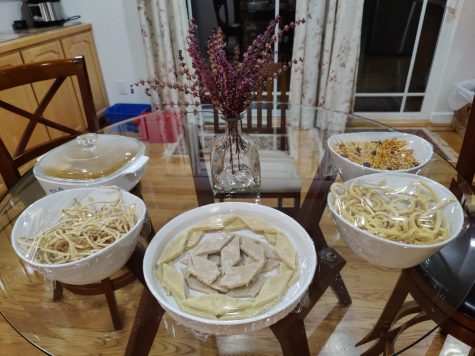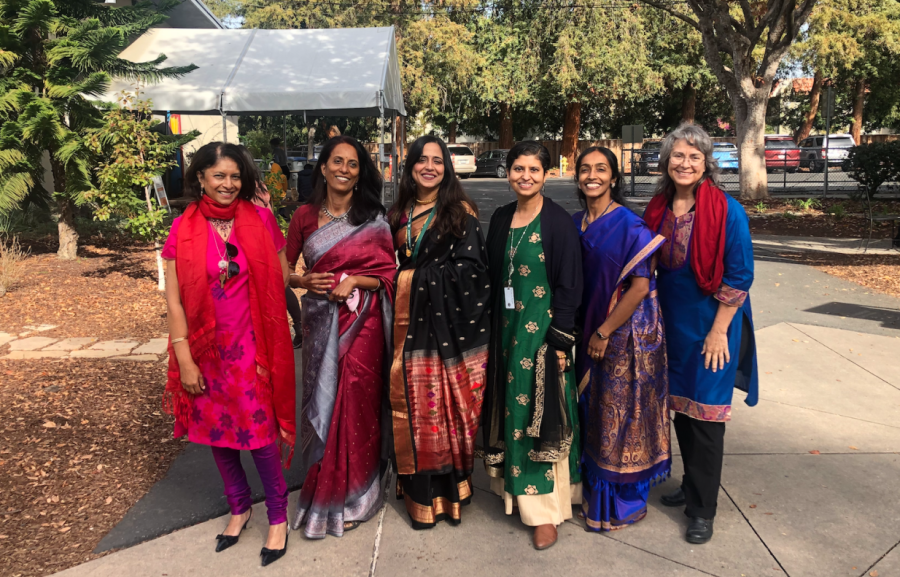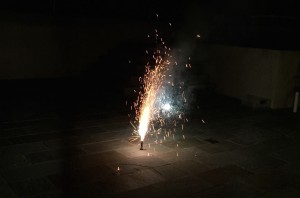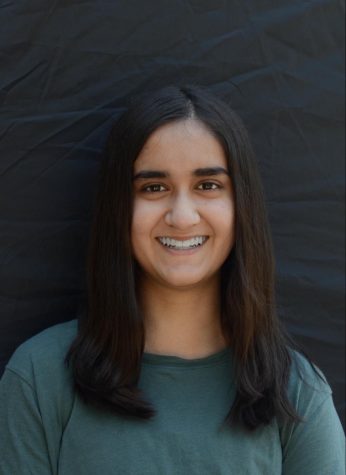Triumph of light over darkness: Students, faculty celebrate Diwali
Provided by Anu Datar
From left to right, upper school science department chair Anita Chetty, upper school chemistry teacher Dr. Mala Raghavan, computer science teacher Anu Datar, attendance coordinator Ritu Raj, upper school mathematics teacher Dr. Anu Aiyer and upper school computer science teacher Marina Peregrino dress in traditional garments to celebrate Diwali. This year, the holiday occurred on Nov. 5.
November 30, 2021
Upper school math teacher Dr. Anu Aiyer wears a sari of wrapped deep purple cloth with a strip of golden embroidery, a piece of the fabric falling behind her shoulder. With her hands lightly pressed together before her, she closes her eyes and a serene expression settles over her face. To celebrate the festival of Diwali, several female upper school teachers wore similar traditional outfits on Nov. 5.
Diwali, a religious festival celebrated by Hindus, Jains, Sikhs and some Buddhists, begins on the 13th day of the lunar month Kartika and spans five days. This year, Diwali lasted from Nov. 2 to 6. The word “diwali” originates from “deepavali,” which means “a row of lights.” Commonly associated with Lakshmi, the Hindu goddess of prosperity, Diwali celebrates the triumph of light over darkness and good over evil. According to Hindu mythology, in northern India, Diwali marks the day that Lord Rama, an avatar of the god Vishnu, returned to his homeland after an exile of 14 years, and in southern India, it celebrates the day Krishna, a major deity, defeated the legendary king Narakasura.
“One of the main stories is that it’s related to Lord Rama coming back from the forest,” upper school chemistry teacher Dr. Mala Raghavan said. “The South Indians also look at another thing called Naraka Chaturdashi. Narakasura was a demon who was killed by the gods, and one of the boons that he asked the God before he died [and] was going to go under the ground where there [is] darkness, he said, “Let the world outside be celebrated with lights.”
Common traditions during Diwali include the wearing of new clothes, and as a personal tradition, Dr. Raghavan wears a sari, a decorative draped garment, every Diwali. In the past, she has worn her mother’s new saris as well as those from her other relatives.

“I used to always wear a sari, inaugurate one of the saris of my mom’s, a new one that she would get,” Dr. Raghavan said. “So I still wear a sari during Diwali, that’s very specific. Wearing new clothes was something that’s traditional with the Diwali celebration, but of course, I don’t always buy a new sari, but this time, I happen to have a new sari which my sister has given [me].”
The setting off of firecrackers during Diwali, another popular tradition, symbolizes the victory of light over darkness. Sriram Bhimaraju (10) describes the different kinds of fireworks his family uses, from those that shoot a few feet into the air and others that explode into vibrant colors when thrown on the ground.
To celebrate Diwali, upper school mathematics teacher Dr. Anuradha Aiyer follows popular traditions such as wearing new clothes and cooking sweets but also incorporates her own twists. Every year, she challenges herself to cook one new sweet: her extensive repertoire now includes Gulab Jamun, a solid milk-based ball with the consistency of dough, varieties of Burfi and Laddu as well as Mysore Pak. Dr. Raghavan’s family also makes traditional South Indian foods such as Thengole, Muruku, and Barfi. Every year, Aiyer’s family plays an important role in her cooking process.
“[Diwali] is a time for families to get together,” Aiyer said. “It’s a symbol of prosperity, of good health, and you want to celebrate and be grateful for all those things.”
Growing up in the south Indian state of Kerala, Aiyer practiced traditions such as waking up early and showering before receiving new clothes. After moving to the U.S., she still maintains several of the same practices, but since the distance from India reduces the presence of Diwali celebrations, Aiyer has started new traditions to rekindle the same feeling of community she felt at home. Every year, she creates gift bags of sweet and savory foods to exchange with friends.
“When I was growing up, the whole neighborhood would all just be festive,” Aiyer said. “[The celebration] was pervasive. And so you bring some of that by just saying, ‘Oh, let’s meet. Let’s exchange. Let’s light firecrackers. Let’s have dinner together.’ Just bringing that celebration.”
For those who celebrate Diwali from a young age, the festival serves as a constant each year, but Samvita Gautham (11) also notes how her role in the celebration has changed over the years.
“Diwali is a very popular tradition and part of our culture, and it’s something I’ve always celebrated since I was little,” Samvita said. “My mom, every year, she’ll include me more and more in the preparations. It’s just like the small things but they all add up to this feeling of family [and] community that happens a lot.”
Sriram usually celebrates Diwali with sweet and spicy traditional foods as well as visits to the temple with his family. For Diwali last year, he recalls the joy he felt reconvening with his relatives after several months apart, even though fewer people could attend the celebrations because of pandemic restrictions. A notable moment from that day includes when he showed his younger cousin how to set off fireworks.
“I feel fulfilled to meet with all of my relatives and celebrate such a wonderful festival,” Sriram said. “I feel grateful that there’s this community that I can do these [traditions] with and that there’s so many people just like you who want to celebrate Diwali. I feel included, like I have a place.”
Additional reporting by Sally Zhu.


















![“[Building nerf blasters] became this outlet of creativity for me that hasn't been matched by anything else. The process [of] making a build complete to your desire is such a painstakingly difficult process, but I've had to learn from [the skills needed from] soldering to proper painting. There's so many different options for everything, if you think about it, it exists. The best part is [that] if it doesn't exist, you can build it yourself," Ishaan Parate said.](https://harkeraquila.com/wp-content/uploads/2022/08/DSC_8149-900x604.jpg)




![“When I came into high school, I was ready to be a follower. But DECA was a game changer for me. It helped me overcome my fear of public speaking, and it's played such a major role in who I've become today. To be able to successfully lead a chapter of 150 students, an officer team and be one of the upperclassmen I once really admired is something I'm [really] proud of,” Anvitha Tummala ('21) said.](https://harkeraquila.com/wp-content/uploads/2021/07/Screen-Shot-2021-07-25-at-9.50.05-AM-900x594.png)







![“I think getting up in the morning and having a sense of purpose [is exciting]. I think without a certain amount of drive, life is kind of obsolete and mundane, and I think having that every single day is what makes each day unique and kind of makes life exciting,” Neymika Jain (12) said.](https://harkeraquila.com/wp-content/uploads/2017/06/Screen-Shot-2017-06-03-at-4.54.16-PM.png)








![“My slogan is ‘slow feet, don’t eat, and I’m hungry.’ You need to run fast to get where you are–you aren't going to get those championships if you aren't fast,” Angel Cervantes (12) said. “I want to do well in school on my tests and in track and win championships for my team. I live by that, [and] I can do that anywhere: in the classroom or on the field.”](https://harkeraquila.com/wp-content/uploads/2018/06/DSC5146-900x601.jpg)
![“[Volleyball has] taught me how to fall correctly, and another thing it taught is that you don’t have to be the best at something to be good at it. If you just hit the ball in a smart way, then it still scores points and you’re good at it. You could be a background player and still make a much bigger impact on the team than you would think,” Anya Gert (’20) said.](https://harkeraquila.com/wp-content/uploads/2020/06/AnnaGert_JinTuan_HoHPhotoEdited-600x900.jpeg)

![“I'm not nearly there yet, but [my confidence has] definitely been getting better since I was pretty shy and timid coming into Harker my freshman year. I know that there's a lot of people that are really confident in what they do, and I really admire them. Everyone's so driven and that has really pushed me to kind of try to find my own place in high school and be more confident,” Alyssa Huang (’20) said.](https://harkeraquila.com/wp-content/uploads/2020/06/AlyssaHuang_EmilyChen_HoHPhoto-900x749.jpeg)










